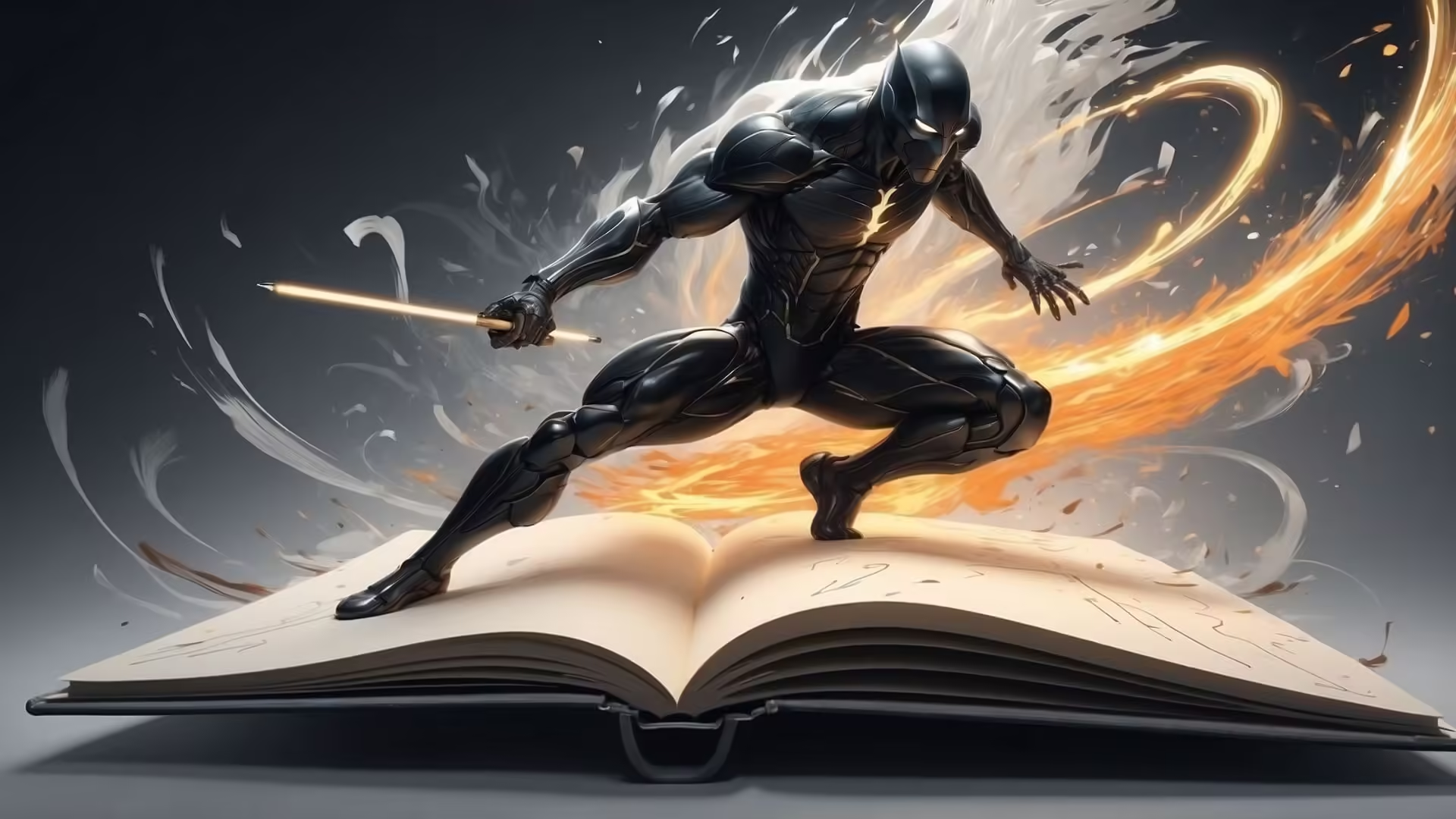- The Gist
- Writing Compelling Action Scenes: Tips and Techniques
- Understand the Purpose of the Action Scene
- Balance Action with Reaction
- Use Short, Punchy Sentences for Fast Pace
- Focus on Sensory Details to Build Immersion
- Keep the Stakes High
- Avoid Over-Describing Every Movement
- Emphasize Emotional Stakes Alongside Physical Action
- Practice Varying Your Sentence Structure
- Crafting Action That Engages and Thrills
- Let’s Talk
- Let’s Learn Vocabulary in Context
The Gist
Writing action scenes is all about creating moments that feel intense, vivid, and real. From fast-paced battles to narrow escapes, these scenes aren’t just about physical movements—they’re about drawing readers into the heart of the action and keeping them on the edge of their seats. To make action compelling, writers need to balance pacing, sensory details, and emotional stakes. That’s just the gist of what this post is about. If you want to dig deeper into the topic, some discussions about it, and learn some key vocabulary from its context, read the post.
Writing Compelling Action Scenes: Tips and Techniques
Action scenes are a vital element of many stories, from thrillers to fantasy adventures. They’re the moments where plot, character, and stakes converge in intense, high-energy exchanges. But writing action is about more than just describing fast movements; it’s about creating a scene that feels alive, drawing readers in so they experience the tension, danger, or excitement right along with the characters. Let’s explore some effective tips for making your action scenes compelling, from building up suspense to crafting clear, vivid descriptions.
Understand the Purpose of the Action Scene
Before jumping into the writing process, it’s important to understand what each action scene is meant to accomplish. Is the goal to build tension, reveal something new about a character, or move the plot forward? Knowing the purpose helps you focus on which elements of the action to emphasize. For example, if you’re aiming to show a character’s resourcefulness in a fight, you might focus on their clever maneuvers rather than brute strength. A clear purpose also prevents an action scene from feeling like filler, giving readers a reason to care about the outcome.
Balance Action with Reaction
One mistake writers often make is focusing only on the physical movements, creating a scene that reads more like a play-by-play than a story. To create a compelling action scene, it’s essential to include the character’s reactions, both physical and emotional. Show the protagonist’s thought process as they assess the situation, decide on their next move, or react to an unexpected attack. This gives the action a sense of immediacy and allows readers to connect emotionally with the character, making the stakes feel real.
For instance, rather than writing, “John punched the attacker, then ducked to avoid another blow,” you could add a layer of reaction by writing, “John’s fist connected with the attacker’s jaw, sending a jolt up his arm. He ducked instinctively, adrenaline spiking as he felt the air whoosh above his head.” The latter version gives readers insight into John’s immediate experience, building empathy and tension.
Use Short, Punchy Sentences for Fast Pace
Pacing is crucial in action scenes. To convey speed and intensity, use short, punchy sentences that keep readers moving quickly through the action. Each sentence should carry impact, driving the scene forward without unnecessary description or tangents. Avoid overly long sentences that slow down the pace; instead, focus on crisp language that mirrors the urgency of the moment. Simple, active verbs also help create a sense of motion.
For example, in a chase scene, instead of describing every movement in detail, you might write: “She sprinted down the alley, heart pounding, footsteps echoing behind her. She leapt over a fallen trash can, barely dodging a puddle as she ran.” This quick, concise writing style makes readers feel like they’re in the scene, running alongside the character.
Focus on Sensory Details to Build Immersion
While action scenes are often fast-paced, don’t overlook sensory details. Incorporating sounds, smells, and physical sensations can add realism and intensity. If a character is in a fistfight, you might mention the sting of sweat in their eyes, the dull ache of a bruise forming, or the sharp crack of a fist hitting bone. These small but powerful details make the scene feel more grounded, helping readers imagine what the character is experiencing.
Sensory details also make scenes more memorable. A reader might not remember every punch thrown, but they’ll remember the sharp tang of blood or the metallic clang of a sword hitting armor. Just be careful not to overload the scene with too many details at once; choose a few that enhance the scene without slowing down the action.
Keep the Stakes High
Compelling action scenes are about more than physical movement—they’re about what’s at risk. Every punch, dodge, or sprint should matter, impacting the characters’ journey and increasing the stakes. What does the character stand to lose if they fail? Is there an emotional cost, such as a loved one’s safety or a loss of honor? Building up the stakes gives the action purpose, adding weight to every movement and decision. When readers care about the outcome, they’re more likely to be fully invested in the scene.
For example, if a character is trying to disarm a bomb, the stakes are clear: if they fail, lives are at risk. But you can also add a personal layer—perhaps someone they love is in the building. This adds emotional depth, making readers root for the character and feel the urgency of the situation.
Avoid Over-Describing Every Movement
In action scenes, less is often more. Trying to describe every single movement can overwhelm the reader and slow down the pace. Instead, focus on the highlights—the key movements, reactions, and sensory details that drive the scene forward. Use strong verbs and dynamic language to convey the action without cluttering it with excess detail.
For example, instead of detailing every swing of a sword in a fight scene, highlight the pivotal moments: a missed strike that leaves the protagonist vulnerable, or a sudden opening that leads to a decisive blow. This approach keeps readers engaged and allows their imagination to fill in the gaps, making the action feel more intense.
Emphasize Emotional Stakes Alongside Physical Action
Physical action is exciting, but it’s the emotional stakes that make a scene truly compelling. As your characters fight, flee, or struggle, show what they’re feeling—fear, determination, rage, or desperation. Action scenes that reveal a character’s inner conflict or push them to their limits resonate with readers on a deeper level. Whether it’s the anxiety of an untrained fighter facing a skilled opponent or the resolve of a hero determined to protect their loved ones, these emotions add depth to the scene.
For example, during a climactic battle, a character might be driven not just by survival but by a need to protect their family or avenge a loss. This emotional motivation gives readers something to root for, making each blow and dodge more impactful.
Practice Varying Your Sentence Structure
Varying sentence structure is another way to control the rhythm of your action scenes. Mixing short, punchy sentences with slightly longer ones can create a sense of momentum while avoiding a repetitive, choppy feel. Use fragments sparingly for added impact, and remember that dialogue in action scenes can break up the pace, revealing character dynamics or inner thoughts in the heat of the moment.
Crafting Action That Engages and Thrills
Writing compelling action scenes is a balance of physical movement, emotional depth, and pacing. By focusing on sensory details, highlighting the stakes, and incorporating character reactions, you can create scenes that not only engage readers but also resonate on an emotional level. Action scenes are an opportunity to reveal character strengths, vulnerabilities, and motivations, making them a powerful tool in storytelling. With these techniques, your action scenes can become more than just moments of intensity—they can be defining moments in your characters’ journeys.
Let’s Talk
Let’s dive a little deeper into action scenes, shall we? Writing them can feel like you’re directing a high-speed chase, trying to keep all the intensity without losing the plot—or your readers! Have you ever read an action scene that just didn’t connect? Maybe it had all the punches and kicks, but it somehow felt…flat? It’s interesting, because action isn’t just about what’s happening but how it’s happening. And the “how” is where you can really bring your characters and stakes to life.
Think about it: every action has a reaction. Let’s say your character swings a punch. Sure, you could just describe it like, “He swung his fist,” but it’s the reaction that makes it feel alive. Does his target stagger back, maybe with a look of shock or anger? And what does your character feel right after? That split second where they see the impact, the moment of “Did that just work?” or even a twinge of pain if they hit harder than they expected. Action feels real when we get those reactions, those milliseconds of processing, because they pull us into the character’s head, even if it’s just for a split second.
And here’s a fun trick: sometimes, it’s what you don’t describe that makes the biggest impact. Like, rather than detailing every single move, you focus on the high stakes or the big turning points. It gives readers the space to fill in the gaps and makes them feel like they’re right there, dodging blows or holding their breath. Plus, letting readers imagine some of it? That can be powerful. So, when writing action, consider letting go of the tiny stuff and putting more weight on the moments that matter most.
Here’s a question to think about: what kind of action scenes do you enjoy reading? Are they those intense, close-up, almost cinematic scenes where you feel every punch? Or maybe the strategic ones, where every move feels like a chess match? It can help to know your own preference because it’ll come through in your writing, making your scenes feel more authentic.
And let’s talk about pacing. It’s kind of like music—some scenes call for a fast beat with quick sentences, and others might need a slow build, where every movement feels heavy with anticipation. It’s all about the rhythm. Maybe your character’s escaping danger, and the words fly by in short, choppy sentences to match the heartbeat. Or maybe it’s a high-stakes standoff, and everything slows, with every tiny detail crystal clear. You’re the DJ of this action playlist—so experiment and see how different rhythms can change the whole feel of a scene.
So next time you’re writing an action scene, think about what you want readers to feel. The punches and kicks are important, sure, but it’s that heartbeat, those little reactions, that make it real. And remember, it’s all about balance—just enough to keep it intense but not so much that you drown in the details.
Let’s Learn Vocabulary in Context
Let’s get into some key words that can help make action scenes jump off the page. First up, pacing. Pacing is about how fast or slow a scene unfolds. In action scenes, fast pacing creates intensity, while slower pacing can build suspense. Think of it like a rollercoaster—you need those dips and rises to keep the thrill going.
Reaction is essential in action scenes. It’s not just what a character does but how they react afterward. A reaction can show fear, surprise, or even a moment of reflection in the middle of the action, making the scene feel more real.
Next is stakes. Stakes are what’s at risk in a scene. In an action scene, stakes can be life, honor, freedom, or even something emotional. The higher the stakes, the more gripping the scene becomes because readers care about the outcome.
Intensity is the level of energy or emotion in a scene. In action scenes, intensity keeps readers on the edge of their seats. A high-intensity scene feels like everything’s moving fast, with a lot on the line.
Sensory details are the sounds, smells, and physical sensations in a scene. They add realism, helping readers feel like they’re in the middle of the action, not just watching it. Sensory details could be the sting of a punch, the crunch of footsteps, or the smell of smoke in the air.
Clarity is another big one. In action scenes, clarity means making sure readers understand what’s happening, even when things are moving fast. Without clarity, action scenes can feel confusing or chaotic.
Momentum is what keeps the action moving forward. Every decision and movement in an action scene builds momentum, pulling readers through each moment with a sense of urgency.
Conflict isn’t just about physical fighting—it’s the tension between opposing forces. In an action scene, conflict can be between two characters, a character and their surroundings, or even internal conflict within a character as they fight.
Anticipation builds suspense before the action starts. It’s that feeling of waiting, knowing something big is about to happen. A well-placed pause or description can increase anticipation, making the payoff even better when the action begins.
Lastly, emotion gives depth to action scenes. Readers want to know not only what’s happening but also how characters feel about it. Whether it’s fear, excitement, or desperation, emotion makes action scenes resonate.
Here’s something to think about: Which of these words feels the most important to you in an action scene? And can you remember an action scene that really pulled you in, either in a book or movie, and how it used some of these elements? Experimenting with these concepts can make your writing more dynamic and engaging.











0 Comments